
On the weekend we went to Kuliapitiya. We met a man some of you may know, Ari. He currently has eleven children who have no parents to care for them. For some, their parents have died. Most, sadly enough, have parents but they have been abandonded by them. Pictured here are the nine we met (pick the odd two out!) plus one that is Ari's granddaughter. Ari gives them meals and pays for their schooling and book fees. He also does the same for fifteen other children in the community.
At
 the moment they all live in the main house, boys at one end and girls at the other. This house is overcrowded at best, so he has begun a new building for them. This bulding(pictured) has 3 larger bedrooms, kitchen and bathroom. This is situated on land of approximately one and half acres that he purchased.
the moment they all live in the main house, boys at one end and girls at the other. This house is overcrowded at best, so he has begun a new building for them. This bulding(pictured) has 3 larger bedrooms, kitchen and bathroom. This is situated on land of approximately one and half acres that he purchased. As we talked, he told us of his vision to start a technical college to provide futher training to the community children so that they could find jobs. He also wants to provide villagers with a cow or chickens, whose produce can be sold. This is not something that he is just dreaming about but has
 already put into motion with what he has. So we are hoping that we can work with him on some of these ideas.
already put into motion with what he has. So we are hoping that we can work with him on some of these ideas. As we were quite close, Prince had arranged to pick up our new pet. We also could see what the locals keep as pets. This cute little fellow is a rock squirrel. He is about three to four times the size of a normal squirel and he is only a baby. The adults grow bigger than a cat and are so fast through the trees, jumping from coconut tree to coconut tree almost like they were flying. It was quite incredible to see. 

They also had a monkey that was chained up. It seemed quite tame as the owners could pat it and feed it. We, however, were told that it would be best not to get too close. I am not that fond of monkeys and was happy to oblige.
The most bizzzare creature that I have encountered in Sri Lanka is the porcupine. This couple have resorted to keeping these fellows in their house to protect them from other villagers, as apparently they taste good. From what I can see they are rather timid too. They  were not content until on their leash and,
were not content until on their leash and,
 were not content until on their leash and,
were not content until on their leash and, despite being spiky fellows, they didn't mind a good pat (make sure you go the right way).
So what did we get? Well, the sqirrels weren't for sale, though we have been offered the next baby they find. The porcupines are like children to them, so we couldn't have them and I will not have a monkey. So we grabbed our tortoise and headed home. He is called Imba, which means turtle in Sinhala. Apparently you have to be careful with the pronunciation though, people, otherwise it might sound like you're swearing. He is slightly too big to escape under the gate and is the resident lawn mower. More on the adventures of Imba later.










 to reclaim the land, these people would lose their homes. If the occupants are tenants, leasing the shanties from someone else, they would neither be given somewhere else to stay nor have their rent returned.
to reclaim the land, these people would lose their homes. If the occupants are tenants, leasing the shanties from someone else, they would neither be given somewhere else to stay nor have their rent returned.  a curtain to divide it into two. The last visit was to a young man who is using all his means to pursue his education and training. His surroundings are humble but he has his eyes trained on the hope of the future.
a curtain to divide it into two. The last visit was to a young man who is using all his means to pursue his education and training. His surroundings are humble but he has his eyes trained on the hope of the future. charity ads and television documentaries and, though we might be moved to an extent, it all seems so distant, as though it couldn't really be real. It is scary how easily we seem to accept that some people must live in these conditions. As long as everything seems O.K. we can forget that, in circumstances such as these, children must die of preventable diseases; parents must grieve; the sick must suffer; the elderly must struggle; widows must grow weary and people must go hungry. Makes you rethink all those little luxuries, doesn't it?!
charity ads and television documentaries and, though we might be moved to an extent, it all seems so distant, as though it couldn't really be real. It is scary how easily we seem to accept that some people must live in these conditions. As long as everything seems O.K. we can forget that, in circumstances such as these, children must die of preventable diseases; parents must grieve; the sick must suffer; the elderly must struggle; widows must grow weary and people must go hungry. Makes you rethink all those little luxuries, doesn't it?! 












